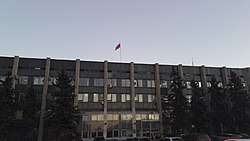Federal Air Transport Agency
The Federal Air Transport Agency (Russian: Федеральное агентство воздушного транспорта), also known as Rosaviatsiya (Russian: Росавиация), is the Russian government agency responsible for overseeing the civil aviation industry in Russia. Its headquarters are in Moscow.[1]
| Федеральное агентство воздушного транспорта | |
 Emblem of the Federal Air Transport Agency | |
| Federal Agency overview | |
|---|---|
| Formed | February 9, 2004 |
| Jurisdiction | Ministry of Transport |
| Headquarters | Leningradsky Avenue, 37/2, Moscow, Russia |
| Federal Agency executive |
|
| Website | favt |
Building details | |
 | |
It is also called the Russian Federation Civil Aviation Administration (RFCAA).[2]
The Federal Air Transport Agency regularly works alongside the Interstate Aviation Committee in investigations of aviation accidents and incidents. Its U.S. equivalent is the Federal Aviation Administration.
History
The Federal Air Transport Agency was established in 2004 by Russian President Vladimir Putin. On March 9, 2004, Putin issued a decree, “On the System and Structure of Federal Executive Bodies,” in which the Agency was created. The Agency received many of the functions of the abolished Ministry of Transport of the Russian Federation.[3]
Leadership
The head of the Federal Air Transport Agency is appointed and dismissed by the government of the Russian Federation. At its creation, the head was Nikolay Vladimirovich Shipil. Other heads followed, and since 2009, Alexander Neradko has headed the Agency.[3]
Functions
The main functions of the Federal Air Transport Agency are the following:
Organization of the execution of federal target programs and the federal target investment program;
Provision of public services of public importance on conditions established by federal legislation to an indefinite number of persons, including for the purposes of: implementing a package of measures to organize the enforcement of international and domestic flights; implementation of a set of measures aimed at ensuring the security of transport infrastructure facilities and vehicles against acts of unlawful interference;
Publication of individual legal acts on the basis of and pursuant to the Constitution of the Russian Federation, federal constitutional laws, federal laws, acts and instructions of the President of the Russian Federation, the Government of the Russian Federation and the Ministry of Transport of the Russian Federation;
The Federal Air Transport Agency is the governing body of the Unified Air Traffic Management System of the Russian Federation.[4]
References
- Home page. Federal Air Transport Agency. Retrieved on January 3, 2012. "Адрес 125993, ГСП-47, Москва, Ленинградский проспект, 37, корпус 2."
- Accident Investigation Board Norway (2 November 1999). "Report on the Accident to Vnukovo Airline's Tupolev Tu-154M RA 85621 Near Svalbard Airport Longyear, Norway on 29 August 1996". www.aibn.no. Retrieved 21 August 2014. p. 5/121.
- Федеральное агентство воздушного транспорта РФ (Росавиация). Справка [Federal Agency for Air Transport of the Russian Federation (Rosaviatsia). reference]. ria.ru (in Russian). 2 July 2010. Retrieved 14 January 2019.
- "Постановление Правительства Российской Федерации от 28 августа 2015 г. N 901 г. Москва "О Единой системе организации воздушного движения Российской Федерации"" [Decree of the Government of the Russian Federation of August 28, 2015 N 901 Moscow "On the Unified System of Air Traffic Management of the Russian Federation"]. rg.ru.

